(Written at La Gondola restaurant, Vientiane, 6:30 PM, 2007)
This afternoon, between first and second dinner, I walked out to the middle of the Mekong. At its peak the mighty river is at least two kilometers across, but now, at the height of dry season, it has narrowed to perhaps a quarter of that. I’m glad, since in wetter months my walk would have been a touch more harrowing. As it is, I was able to get a fascinating hint of the lifeblood of this entire region.
Cutting sneakily through the main tourist waterfront drag of Vientiane, running a gauntlet of “Tuk-tuk!” and “Hello! Where you go!” was the first step in my walk. Past the shops and restaurants, I elbowed through head-high grasses and edged down a steep footpath and found myself on a narrow mudflat that twitched with ruddy-coloured frogs no larger than my thumbnail. They were so small and moved so erratically that I first thought they were bugs, and I may have stepped on some before I even noticed them. Stepping lightly and slowly didn’t scare them from my path consistently enough and I eventually took to crouching and blowing furiously at the ground before each step. This odd behaviour seemed to scare off the tiny beasties (who were far too well camouflaged for their own good) and, more important, much amused the five Lao teenage boys who greeted me at the water’s edge.
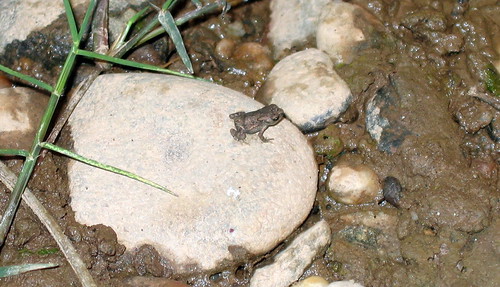
They waded in a torpid stream that branched off the main river for about a kilometer before rejoining it. Like a dozen others I passed on my walk, they were fishing by hand. Taking turns, each would vanish briefly in an explosion of bubbles and, and then re-emerge clasping a wriggling six-inch fish between both hands and smiling in triumph. The water was too muddy to open one’s eyes underneath, so they must have been fishing by touch alone, and yet they rarely resurfaced empty-handed. I couldn’t tell if they were doing it for food or sport – I didn’t see a bucket for storing the catch, and their infectiously cheerful competitiveness reminded me more of a game of street hockey than a work session.
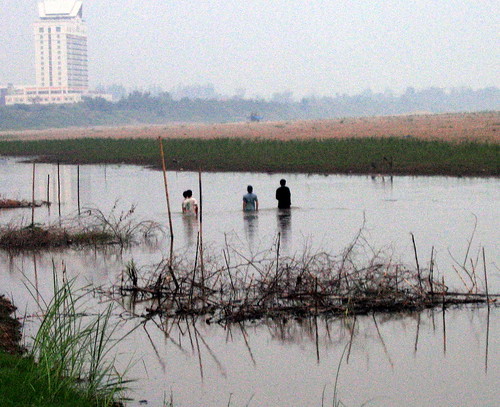
They and several more obviously industrious hand-fishers along that tributary gave me a tiny hint of what the Mekong river and its branches mean to the people of this region. Most Westerners (myself included, until today) know the river mainly as a charnel house for American soldiers during the Vietnam War (known here, by the way, as the Second Indochinese War). I wish more visitors here would try to get to know the river a little better – drinking a Beerlao at a waterfront bar, while great fun, doesn’t really count.
I picked my way across a makeshift bridge of driftwood across the muck and mud and onto the vast sand island, at least a kilometer wide, that sits in the middle of the Mekong. I met six kids playing an amusing game of piggyback boxing. They smilingly obliged my photos.
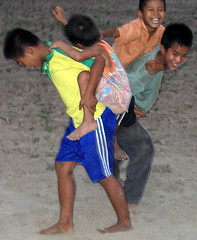
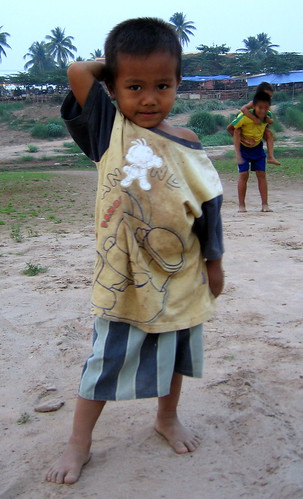
A few more locals whirled on dirtbikes in the distance. At the edge of the river proper, a few dozen Lao leapt briefly (or were shoved) into the water. The river was several hundred meters wide, swift-moving and unnervingly deep. The occasional small ferry plied its way – too late in the day for much traffic – and in the fading daylight I could dimly see the distant lights of riverside industry through the rust haze of the burning season.
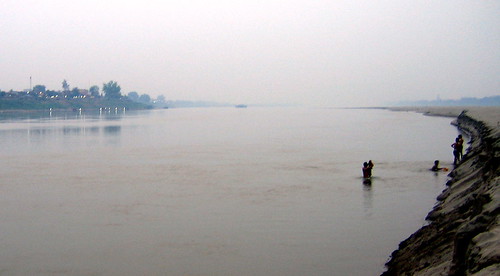
Why am I making such a fuss over this simple river? Because there’s a casual intimacy in these people’s relationship with the Mekong that took me by great surprise. At home, a river is mainly an obstacle to be bridged, and then rarely considered except by those who make their living on the water.
But here the river provides everything to virtually everyone. The Mekong is not merely the lifeblood of the people of Southeast Asia, it’s their highway, their playground, their supermarket and, let’s face it, their sewer. A quarter of a billion people in six countries live and die by what happens to this river. Until I saw it I had no idea of how important it is. At the least, I’m newly convinced that no traveler has really visited Southeast Asia until they’ve set a foot in the Mekong.
No comments:
Post a Comment